
Uzbekistan • 06 May, 2025
Happy bird's chest: Art gallery HAPPY BIRD
In almost every old town, there’s a treasure chest-like store that, upon entering, feels like stepping into a timeless world. These stores are usually decorated with antique mirrors and furniture, oriental carpets, paintings, and unusual lamps, with items inside the "treasure chest" begging to be touched, smelled, and admired endlessly. The HAPPY BIRD art gallery in the Samarkand Crafts Center is just like that, but with the added charm of birds. Happy birds – in the form of garlands, plush toys, figurines, decorative items, plates: seagulls, owls, jackdaws, roosters, peacocks, swans...
The gallery opened its doors in late 2005, but the official launch with the release of doves took place on June 4, 2006. HAPPY BIRD primarily sells women’s outerwear made from vintage and contemporary fabrics, and when you buy an item here, you can be sure that no one else will have the same one. The creator of this wonder, which is among the top must-see places in Samarkand according to guidebooks, Elena Ladik, answered our questions. We invite you to immerse yourself in the enchanting world of birds, fabrics, and magical stories.
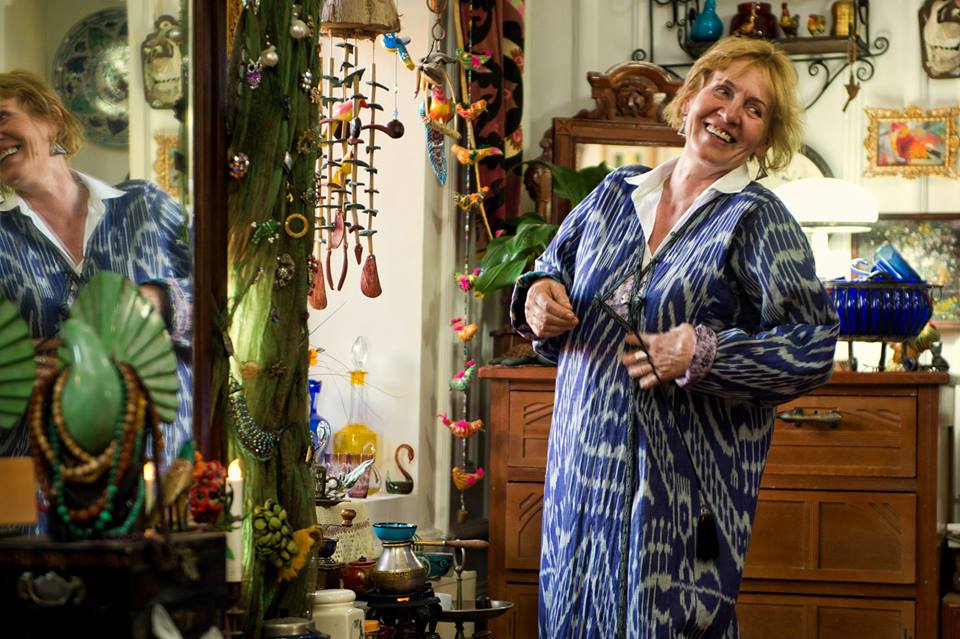
"I was born in Ukraine, in the city of Kirovograd (now Kropyvnytskyi) in 1952. It's a lovely town, with the central district built in the Art Nouveau style and streets often paved with cobblestones. Our house was located on the outskirts, near the Ingul River, where we swam until we turned blue, played Cossacks and robbers, and the bravest ones managed to slip through the barbed wire to the guarded area of a massive railway bridge over the river. This bridge, made of huge stone blocks, resembled an ancient castle in the evening light. The grass on the enclosed area was thicker, the flowers more lush, and the risk of being punished added an extra edge to the sensations. I think the guards noticed us all the time, but only in rare cases would the 'bridge guard' raise his rifle to frighten us, and then the daredevils would escape, scratching themselves on the wire.
Bringing a bouquet from the 'zone' to my mother was considered a special chic, and the parents didn’t realize the risk their mischievous children were exposing themselves to. In winter, we would skate, sled, cross the frozen river to the other bank to steal sticky sweet molasses from the tankers, which we would wrap around sticks and enjoy its unforgettable taste in the moonlight. Such a simple post-war childhood was our lot, for which I am infinitely grateful to fate.
I remember how we collected poor reproductions of paintings, mostly from magazines 'Rabotnitsa' and 'Krestyanka', glued them into notebooks, walked 5 kilometers to the library across a high railway embankment, and studied at a school where there had once been a seminary. Unfortunately, the dream of becoming an art historian was postponed for several years: at the insistence of my parents, after the eighth grade, I had to enter a machine engineering technical school, and upon completing my studies, I chose Tashkent. The East seemed like a very attractive place to live, and I did not regret my choice. Thus, fate forever linked me with Uzbekistan, where I was able to realize myself as a person and pursue a profession that endlessly fascinates me. I studied part-time at the St. Petersburg Academy of Arts named after Ilya Repin in the art history department, and then had an interesting experience working at the Fergana Regional Museum of Local Lore, where I created the arts department and managed it for many years. And then, in 2005, my HAPPY BIRD came into being." – Can we start with the birds instead of the clothes? We read that the gallery's name was inspired by the movie 'Birds' (Le Peuple Migrateur, 2001. Literally, 'Birds – the migratory people'). Is that right? – The name of the gallery didn’t come immediately, but a few years after it began, and at first, there was some confusion with the name: sometimes the posters said 'HAPPY BIRD,' sometimes 'HAPPY BIRD' was listed as 'SÇASTLIVAYA PTITSA' ('The Happy Bird'). The first birds to join the gallery were live doves. At the opening, with the onset of dusk, we lit up lanterns made from woven birdcages. Inside these cages were multicolored light bulbs, adding an extra colorful note to the festive mood of the buffet. For additional effect, we bought a few doves from a neighbor who kept them and released them when the lights came on. It was beautiful, but not many guests noticed our maneuver – by then, the champagne reserves were quite low, and everyone was absorbed in conversation and tasting the food. The birds returned home, and we had a beautiful shot from our photographer friend Nabi. After that, the next birds became permanent residents, brought from numerous trips, and gifts from children, friends, and, especially, those guests who visited us more than once. I fondly remember everyone who has contributed and continues to add to our bird collection. Magda from the Netherlands brought us a blooming geranium pot and a family heirloom – a sea gull from her mother’s house. My dear friend Naima, hiding from the rain in an antique store in Germany, bought us some charming birds... There were so many such moments, and they not only decorate the interior of the salon but also enrich my life. The birds in the gallery are not for sale, although there is a great demand for them. Only once did I want to teach a lesson in prudence to a guest who didn’t take my polite refusal to part with a small wooden tit. He bargained persistently, reaching an absurd price. His companion was impressed by her man’s persistence and encouraged him with admiring looks. To end the long negotiation, I stopped him by saying, 'I’ll wrap it for you now!' But that was the only case of 'bird business.' Occasionally, we gift duplicates of the birds from the salon to particularly cherished guests, but we still prefer that they 'come flying' to us from everywhere. Collecting something requires systematization, and since I don’t know how to do that and don’t want to, due to my spontaneous nature, I cannot answer the question of how many and what kinds of birds live in our salon. However, in our yard, there are quite lively and cheeky Indian mynas (mynas), wild pigeons (turtledoves) have settled on the vineyard, and in spring, some small bird sings beautifully in praise of the Creator. – The first thing you feel when stepping into the gallery is that you’re genuinely welcome here, without the annoying 'buy-buy-buy' attitude, which is noticeable within the first minutes. How was your magical space created and filled? – Our salon is located in the Crafts Center on the outskirts of the Bukhara Jews' neighborhood. Perhaps this building once belonged to a wealthy representative of this colorful diaspora, so the space itself is very fitting. I designed the interior myself, without a designer. Since we mostly sew clothes from vintage fabrics, I wanted to create a whimsical space in the style of an antique shop – a kind of 'nostalgic little store' from Woody Allen's movie Midnight in Paris. Our flea markets still delight with artifacts of the past, and 18 years ago, there was an opportunity to buy an amazing collection of vintage and antique items. And, of course, friends understood the task and gave old mirrors, chairs, and other luxuries. The gallery also features ceramic works by famous Uzbek masters from Rishtan – Sharofiddin Yusupov and Alisher Nasirov. All these items helped form the image of the gallery, which guests remember as something unlike other similar establishments. I want to emphasize that we only sell clothing that we make ourselves. The robes from the Bukhara Jews' trunks that I hung in the second room are part of the interior and are not for sale. The books can be flipped through, the felt hats can be tried on and photographed, but we do not sell them, nor the brooches. Occasionally, we make exceptions and give something from this category away. We often get asked: 'Do you live here?' That means we’ve succeeded in creating a homely atmosphere, and that's a good thing. – Recently, another one of your spaces opened in the Eternal City? – Yes, we were given a gorgeous two-story 'mansion,' the first floor of which is dedicated to an exhibition of costumes from the gallery’s collections of various years, and the overall interior has a museum-like feel thanks to historical photographs and ethnographic items. On the second level, I plan to organize a café for friends, so we can chat and host thematic meetings in a cozy environment with a beautiful view of the water and a distant perspective. But that’s still in the plans; for now, only the first floor is ready. – Let’s now move on to the clothing, which is so similar to the feathers of exotic birds... – Our main collection consists of women's outerwear: coat-robes, jackets, and coats. There are also a few hats, which were sewn to complement collection models, but then, for various reasons, the ensembles were broken up, and these hats became objects of attraction for buyers – lovers of unusual accessories. For our models, we mainly use vintage fabrics of very high quality, created at a time when manufacturers adhered to all the requirements of GOST (State Standard). They are natural – silk, wool, cotton, and mixed fabrics. These fabrics are carefully stored in chests as an investment in the family budget and the main gift fund for various events. We also buy handwoven fabrics from artisans from the ancient city of Margilan, in the Fergana Valley. They are made manually according to an ancient technique of applying patterns to threads before they are placed on the loom. This technique is called 'abrovoy' in our language, and in the world, it's known as ikat. Sometimes, we purchase modern factory-made fabrics, but you can’t always be sure of their natural quality, as today’s technologies can conceal the presence of synthetic materials. We rarely use them, as long as the vintage fabrics are enough. The vintage fabrics are stored in cuts, so we can’t make standard models, and each time we have to improvise based on what we have in stock. That’s why all our items are unique – no two are alike! Where and how do we find fabrics? While answering your questions, I got distracted by a surprise visit from my supplier friend, who brought two hefty bundles of precious content. How can I resist and not buy them?! Though at home, I've accumulated such a stock of these treasures that in my lifetime, I surely won't be able to sew everything... And then, how will I place them? That’s an even more serious problem... But... my God! Chiffon, crepe-de-chine, panne velvet, and other madapolans (a very thin cotton fabric with high durability) – how can I resist! These destroyers, these tempters, my friends, are the first to bring their spoils to me for inspection, knowing they’re doing a good deed. Occasionally, we come across antique fabrics. This is the traditional Uzbek hand-block printing from the late 19th – early 20th century. After the annexation of Turkestan to Russia, cheap Russian calico was imported here, and the ancient craft of block printing, which is very labor-intensive, couldn’t withstand the competition and gradually began to disappear. Only about 25 years ago, the government took steps to revive this type of applied art, and now there are masters working in this technique. If the old block printing is in poor condition, we carefully select intact pieces to use in the creation of clothing. I don’t want to destroy a whole composition, so I acquire high-artistic specimens with the idea of someday holding a good thematic exhibition, presenting a retrospective of the rise, decline, and revival of this national craft.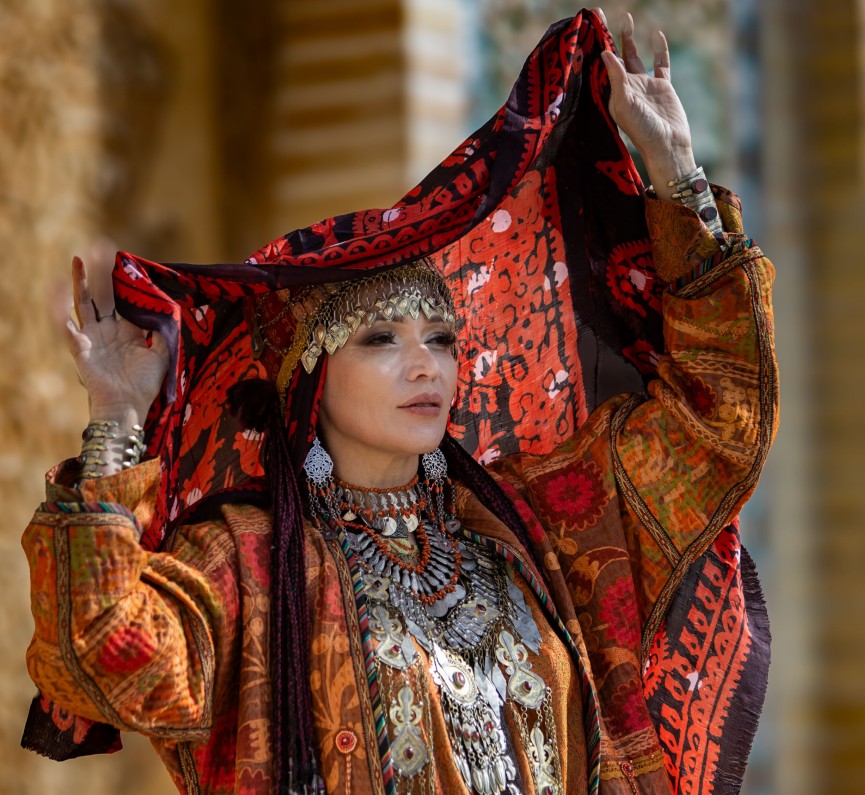
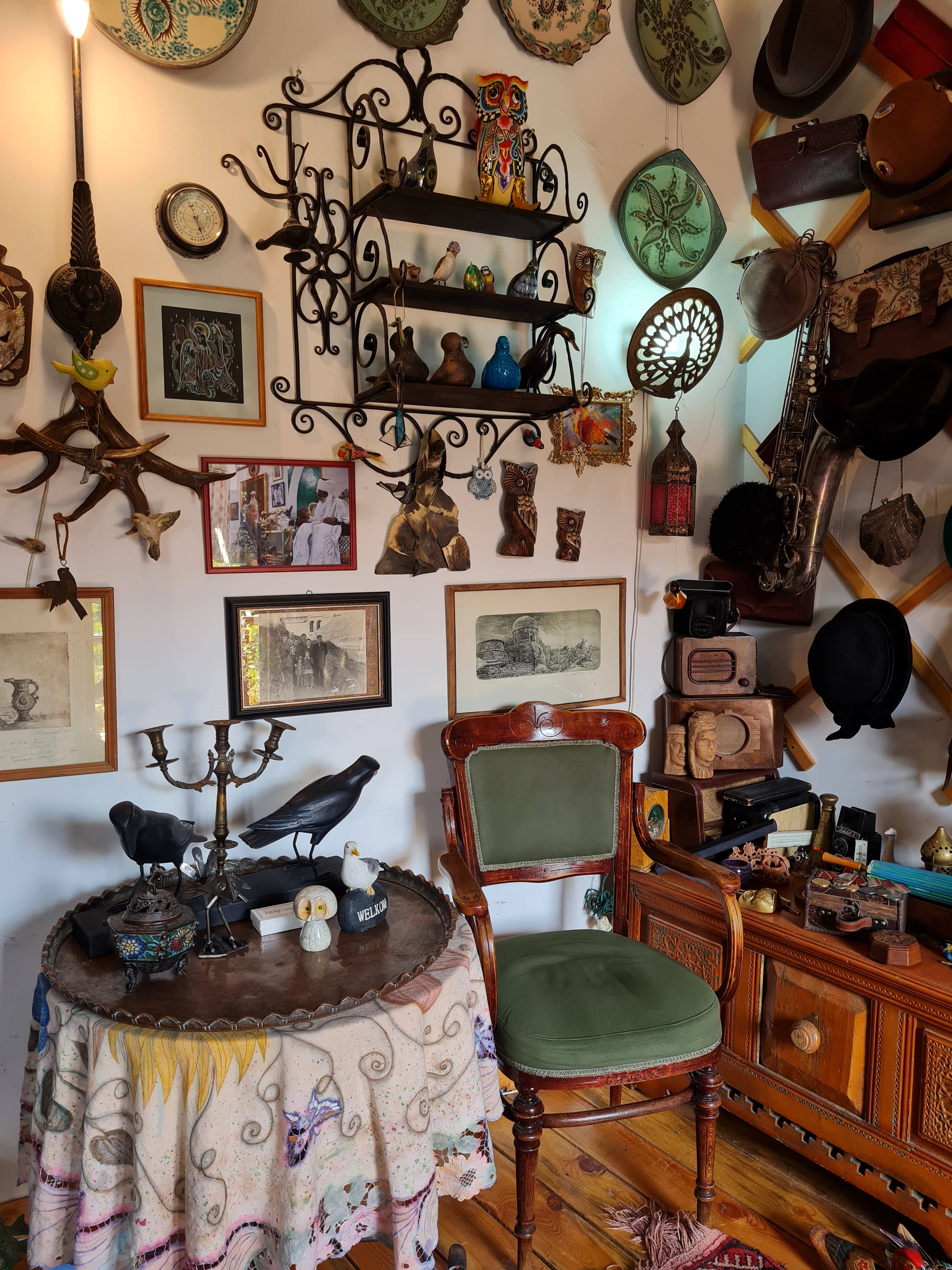
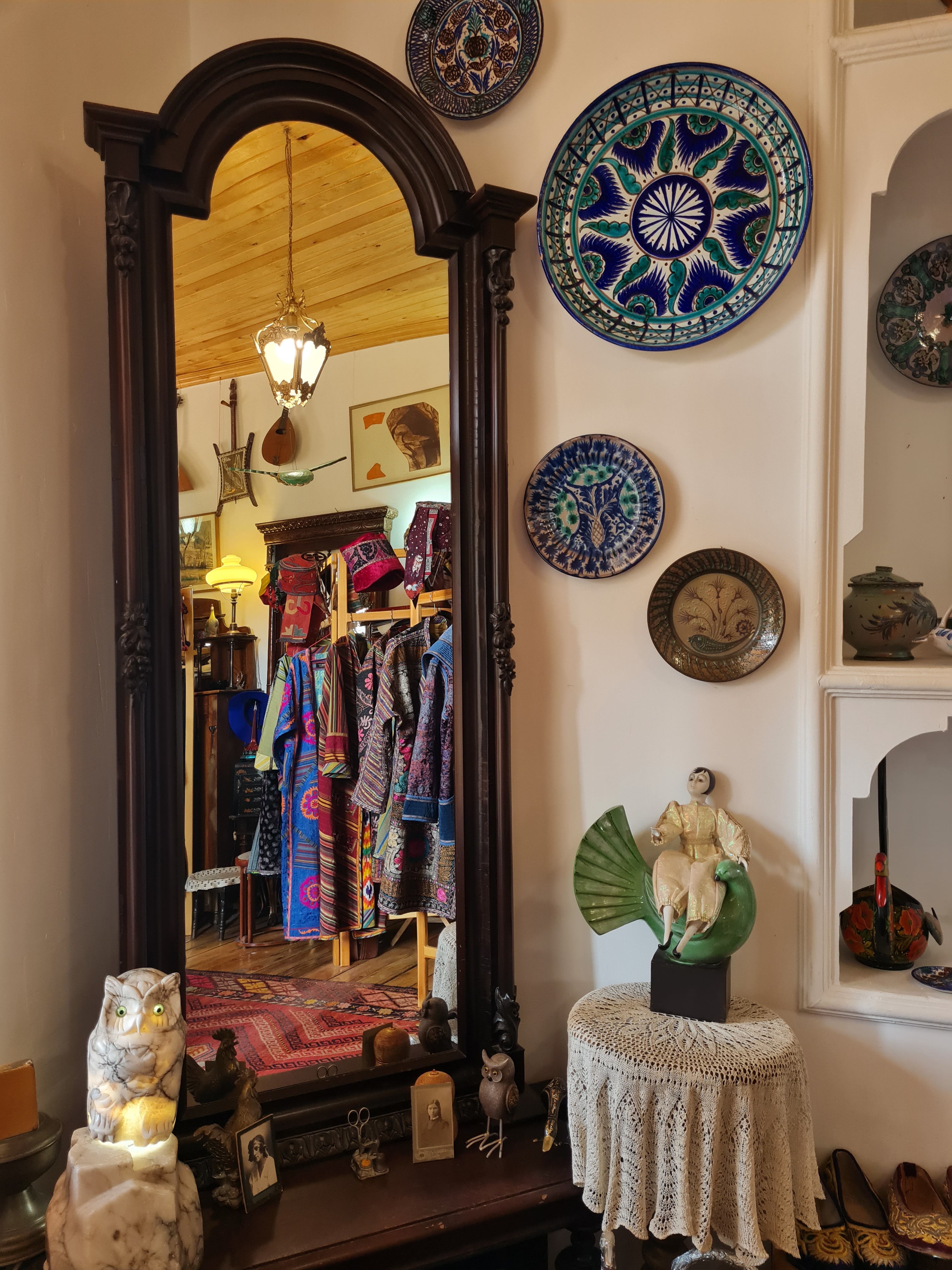
– So, looking at all the brilliant creations made by people, whether architectural or technical wonders, clothing or paintings, the question arises: how are these ideas conceived and brought to life?
– I prepare the fabrics for future garments myself – washing them, dyeing them, selecting fittings, decorative elements, and roughly pinning the shape on a mannequin, which is then refined in detail by the designer. All of our employees work from home, and it’s not just about the lack of space to organize a workshop, but the convenience, especially for those who have children and run a household. Sometimes, five people work on a single robe – someone has to do the block printing, someone adds patterns in batik technique, someone decorates with hand or machine embroidery, someone quilts – and then the bag with the cut garment returns to the designer, who completes the final assembly. And then the sewn robe is decorated, if necessary, with beads or hand embroidery – this kind of beauty 'can be passed down through generations,' as one of our guests said.
It’s a long process! But the more handmade creativity is invested, the more interesting the result. Nowadays, throughout the city, the so-called 'abai' – unlined simple-cut robes – are sold like hotcakes. Tourists buy them up quickly – it’s a good business, but not for us.
– What style would you say your clothing fits, and which ladies does it suit? We create designer clothes in the ethnic style. The cut of these robes is adapted to modern proportions, and in addition, they pair well with basic clothing and sneakers, without looking too ethnic. The decoration of the robes also has a general eastern character and is not tied to a specific ethnicity, although, of course, we draw from traditional lines. There’s now an opportunity to get acquainted with national art not only in the museums of Uzbekistan but also through collections of Uzbek material culture in museums around the world. Our story is for those girls who are internally free, open to communication, curiously interested, and know how to mix things that seem incompatible. I sometimes admire the ladies who hold impromptu photo sessions at our place – there’s a lot to learn from them! Everything looks good on them, and they don’t wait for your advice on which hat goes best with the outfit; instead, they carelessly put on the one they like most – and that’s the perfect choice!
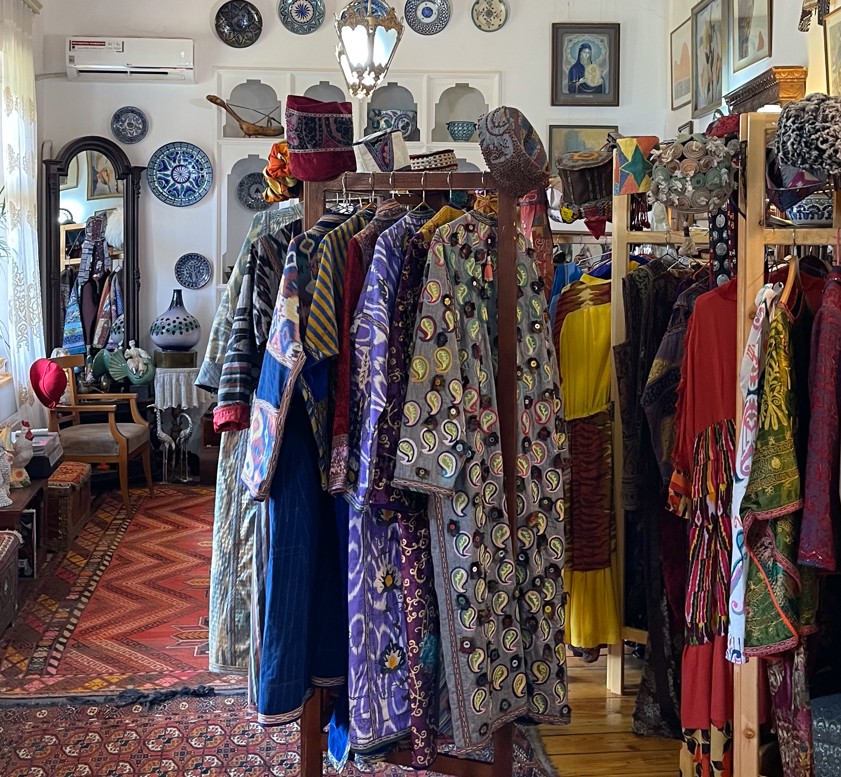
– We noticed that men can’t tear themselves away from your treasures. Do you have a special men's collection?
– We haven’t fully figured out the men's line yet, but many of the models can be perceived as unisex. I think we’ll develop a detailed men's collection soon because we don’t want to miss such a promising category of customers as men on vacation. They want to change their style, even if only for a while, and take a break from the stereotypes imposed by social life. Moreover, many of them approach their wardrobe with creativity and feel quite comfortable in designer outfits.
– Elena, can we mention the price of the items sold in the gallery?
– For some reason, I always feel awkward selling what we create: perhaps it’s a leftover complex from the Soviet era when we viewed retail workers with disdain, and now I pay for it – I’ve become that way myself (smiles). Do you remember the character from Alice in Wonderland who was outraged: 'I asked not to call me an executioner; I’m an executioner!' That’s how I feel about selling – putting a price on something. Though I understand that without profit, there’s no possibility of working creatively, and I shouldn’t have started my own business without thinking about it. I value my assistant Madina for her complete lack of this awkwardness. She graduated from the Cooperative Technical School in Samarkand, worked for a while as a store clerk, and then spent many years working at one of the first art galleries in Samarkand. We’ve known each other for ages, but that’s all. Over the nearly 18 years of the gallery’s existence, I’ve had many colleagues and assistants for various reasons. The specifics of gallery work are unique: maintaining order, greeting guests, telling them about our work in a way that doesn’t seem like pushing products, and looking a certain way to match the general style. One of my favorite and most valued employees, Alinochka, moved to the capital, and the beautiful Nargiza got married, and at one point, I was left without support. Help from above was disguised as a fortunate turn of events: a couple of years ago, I was returning from Moscow after a collection showing at Gostiny Dvor, and in the seat next to me on the plane was Madina. That solved the tricky task... Of course, being spontaneous by nature, I needed someone with a practical mindset – opposites attract, as they say... We try to learn from each other the qualities we lack. I hope this tandem is strong and will be beneficial for both of us. The price of the HAPPY BIRD items ranges from $100 to $2,000. If the embroiderer from Shakhrisabz spends over a year embroidering a robe using canvas (working with a drawing is easier), then such an item must, by definition, be expensive. In other cases, we have a multi-step process: five people 'work their magic' on a single piece – everyone has to earn, and something must go into the gallery’s fund. We have seasonal sales, and in winter, there are almost no tourists, so the whole team has to be supported – that’s how our pricing process works. – Can you tell us about one of your activities – participation in fashion festivals and exhibitions? For those who cannot visit Samarkand, this is a chance to experience your collection. – One of the most recent off-site events was the 'Unique Russia' project at Gostiny Dvor in Moscow. At the invitation of the Eurasian Association of Ethno-Designers, we showcased the collection 'Under the Protection of the Heavens,' inspired by the 7th-century fresco from the Afrasiab settlement. We also had a trip to the legendary 'International Folk Art Market' (IFAM) in Santa Fe, New Mexico (USA) in 2021 and presented the collection at an international festival in the city of Shakhrisabz. Unfortunately, we have to turn down many projects. The main reason is the difficulties in transporting collections – they are very heavy: a costume includes a robe, dress, shoes, headwear, and accessories. If the organizers don’t pay for shipping, then with today’s technology, it’s easier for us to showcase our collections online and save money to continue our creative work. The diplomas we’ve received for participation are not displayed on the gallery walls – they are kept in our home archive, and I hope that when the time comes, the children and grandchildren will look at them.
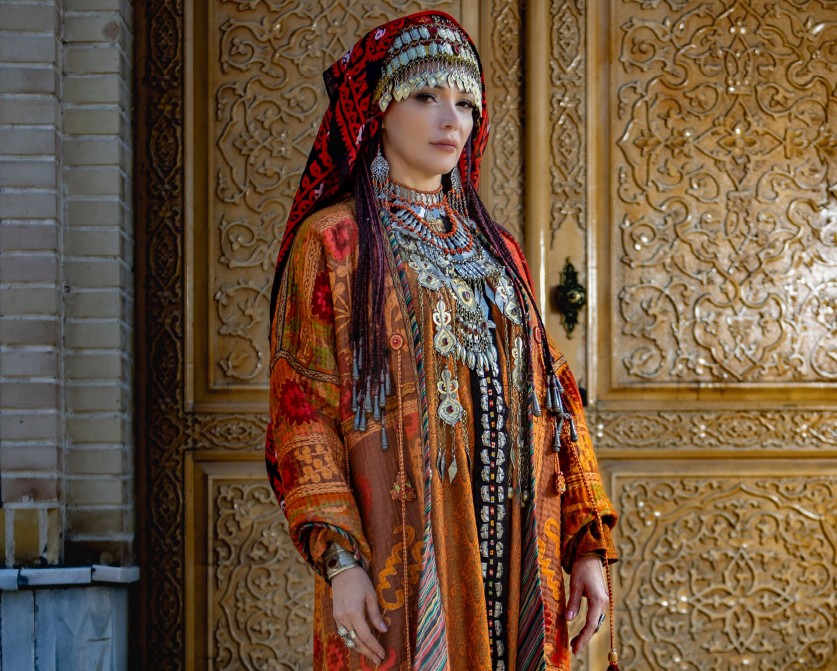
– You speak so modestly about the diplomas you’ve received, but let’s tell our readers that you have 'Quality Mark' certificates from UNESCO for your clothing collections.
– I’ve already mentioned that systematization is not my strong suit. Once, we received an invitation to participate in an exhibition to receive a quality certificate from UNESCO. They sent us a questionnaire, we filled it out, sent photos of the 'Paths of the East' collection, which we had previously prepared for a festival in China, and then we took the costumes to the city of Margilan, where the event took place.
The head of the committee awarding certificates, Natalia Konstantinovna Musina – a restaurateur, gallerist, and art historian – has always been fond of our presence in Uzbekistan’s fashion space and loved visiting the gallery during her trips to Samarkand. That’s how we received the prestigious award. However, I asked for the certificate to be issued in the name of HAPPY BIRD, not Elena Ladik, justifying the request by saying that our creativity is the collective work of the team I assembled, not just my personal achievement. But... when the certificate was presented, I was told I was too modest, and I had to ask my husband to Photoshop something so I wouldn’t be ashamed to show this valuable document to my colleagues.
– Which celebrities have visited your gallery? – I don’t collect celebrities, and we welcome all guests with equal warmth, regardless of their social status. In the salon opposite the door, there is a photograph of the wonderful Lesli Lababidi. She is wearing our robe in front of the Nigerian ruler, who is handing her a cultural ambassador’s diploma. Lesli made a wonderful film about glassblowers from Nigeria, writes travel guides, and hosts TV shows in Cairo. She’s American but has lived in Egypt for many years, and I’m proud to be friends with her. – And if we step outside the gallery and the Crafts Center, where does Elena Ladik like to go in Samarkand? – Thanks to visits from friends and guests, my usual route 'home – gallery – home' expands into full cultural programs: visiting our famous architectural sites, sacred places, and trips outside Samarkand – to Urgut, with its bazaar and the famous Upper Chinary Nature Reserve, where you can sit by a spring, watch trout, and enjoy the cool shade of ancient trees. The last time, my husband – archaeologist Gennady Ivanov – acted as our guide. Many years ago, he participated in an excavation in the mountainous Urgut area, where they found a Christian temple abandoned by its inhabitants in the 13th century. It was fascinating to listen to his story, being in a picturesque place, where it’s easy to imagine how fleeting time is and how fragile all our values are. Editorial note: Birds have always held a special place in Eastern mythology. The most famous is the Humma bird, also known as Simurg, the queen of birds, an ancient symbol of wisdom, freedom, and happiness, depicted on the coat of arms of Uzbekistan. While working on this piece, we were collectively amazed at how many birds appeared in our field. For example, we were simultaneously working on another piece about the family of hereditary ceramists, the Rakhimovs from Tashkent, whose workshop is also adorned with many winged creatures! Or another example: in one of the biographies of the traveler and author, American Lesli Lababidi, mentioned by Elena, it’s stated: 'A lover of birds and nature.' Even the last name of our author, Marina Gulyashcheva, according to one humorous version, derives from the word 'gull, seagull' – a seagull. It’s hard not to believe: it’s all not a coincidence.

Gallery HAPPY BIRD
Address: Samarkand, Islama Karimova St., 43A (formerly Tashkent St.), Crafts Center, 2nd floor
Phone: +998(93) 720-42-15
Website: h-b-art.com
Instagram: instagram.com/hbartgallery
Editorial advice: Dedicate at least an hour to the Crafts Center, there’s plenty to explore. On the second floor, next to HAPPY BIRD, is the gallery of local artist Ahmad Umarov. On the first floor, you can purchase suzani, jewelry, leather goods, robes, ceramics, including ceramic Christmas ornaments. The courtyard, covered in vines, will make you not want to leave – make sure to have a photo session on the stairs or the second-floor gallery.